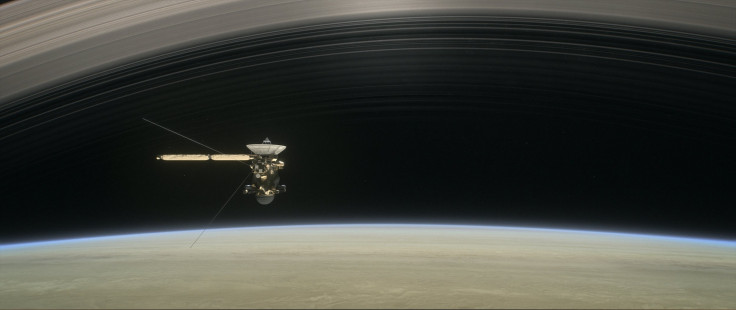Cassini Grand Finale: Spacecraft Beginning Its Final Five Flybys Of Saturn's Atmosphere

The Cassini spacecraft will end its 13-year exploration of Saturn and its surroundings come September. The craft that launched in 1997 made it to Saturn in 2004 and has beamed back information for more than a decade.
On Monday, Cassini will begin the end of its Grand Finale that will come to an end on Sept. 15 when the craft dives into Saturn’s atmosphere to a fiery end. The craft has five more orbits to complete around the planet during which it will pass through the upper atmosphere of the gas giant.
Read: NASA's Cassini Will Burn Up In Saturn's Atmosphere In 'Grand Finale': Images From Its Mission
The first of the five will occur just after midnight in the early hours of Monday morning EDT. The first pass will decide how the following four will be controlled from the ground. As Cassini passes through the atmosphere that is also thick, it will need its small thrusters to stabilize and stay on course. NASA has planned for this, to a certain extent. If the thrusters end up needing to operate at more than 60 percent of their capability for the first pass, the subsequent passes will be conducted at a higher elevation, said NASA in a press release. This is called a “pop-up maneuver” and is designed to lower the amount of energy needed from the thrusters.
These conditions are similar to those found on Saturn’s moon Titan, where the craft has already flown. The team has used the information learned from the Titan flybys to better prepare for flying low in Saturn’s atmosphere.
If the atmosphere actually ends up being less dense and requires less energy and fuel from the thrusters the mission engineers controlling Cassini are also prepared to use a “pop-down maneuver.” Essentially lower the craft closer to the atmosphere for the final two passes. Ideally the craft will be able to fly as close to the cloud tops of Saturn as possible to collect data there on the chemical, elemental and isotopic structure of the atmosphere.
Read: 6 Amazing NASA Cassini Images That Illuminate Saturn, Its Moons
The entire time Cassini maneuver the atmospheric dips, it will collect and transmit data back to Earth on Saturn’s atmosphere that no probe has ever been close enough to detect. Cassini’s preliminary dips into the atmosphere will give researchers the information they need to design a mission to Saturn’s atmosphere in the future.
When the time for the final plunge comes, Cassini will have all seven of its instruments on and transmitting to Earth, although they won’t transmit for long. Once the craft reaches the point in Saturn’s atmosphere where the density is twice that of these five flybys the thrusters will stop working and the antenna will likely end up no longer pointing towards Earth. Soon after the craft will break to pieces and burn up.
© Copyright IBTimes 2024. All rights reserved.





















